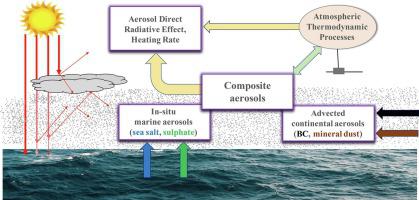当前位置:
X-MOL 学术
›
Atmos. Res.
›
论文详情
Our official English website, www.x-mol.net, welcomes your feedback! (Note: you will need to create a separate account there.)
Accumulation of absorbing aerosols over the Indian Sector of Southern Ocean during the austral summer: Role of thermal inversions
Atmospheric Research ( IF 5.5 ) Pub Date : 2024-03-19 , DOI: 10.1016/j.atmosres.2024.107351 Avirup Sen , Atiba A. Shaikh , Harilal B. Menon , Mukunda M. Gogoi
Atmospheric Research ( IF 5.5 ) Pub Date : 2024-03-19 , DOI: 10.1016/j.atmosres.2024.107351 Avirup Sen , Atiba A. Shaikh , Harilal B. Menon , Mukunda M. Gogoi

|
Optical properties of aerosols and their direct radiative effect were analyzed from columnar Aerosol Optical Depth (AOD) and ambient Black Carbon (BC) mass concentration (M) estimated during Indian Southern Ocean Expeditions (SOEs), conducted in the austral summers of 2016–17 (SOE-IX) and 2017–18 (SOE-X). The aforementioned observations were supplemented with concurrent vertical soundings of the lower atmosphere. Cloud-Aerosol Lidar with Orthogonal Polarization (CALIOP) data aided in investigating the vertical distribution of aerosols up to 10 km altitude. The relative contribution of BC aerosols emanating from fossil fuel combustion and biomass burning showed the former to be predominant, as the latter is larger and preferentially scavenged during long-range transport to remote marine regions. The highest values of AOD at 500 nm (AOD; 0.156 ± 0.026) and M (90.78 ± 40.11 ng m) were encountered in the region between 50 and 60°S. Consequently, the atmospheric clear-sky Aerosol Direct Radiative Effect (ADRE; +3.10 ± 0.38 W m) and heating rate (HR; 0.087 ± 0.011 K day) were also observed to be the highest in the region. Multiple atmospheric inversions were detected between 40 and 69°S. Although a much lower AOD (0.070 ± 0.017) prevailed between 60 and 69°S, the average clear-sky ADRE (+1.56 ± 0.49 W m) and HR (0.044 ± 0.014 K day) were fairly high. The mean M in the region was high (68.81 ± 28.40 ng m) for the pristine ice-covered region. Low-lying inversions prevented the vertical ventilation and dispersal of BC therein. Simulations of BC-induced atmospheric heating rates at three locations in the coastal Antarctic waters indicated a ≈ 3–5-fold increase, corresponding to an increase in ambient BC from 50 to 300 ng m.
中文翻译:

南大洋夏季期间吸收性气溶胶在南大洋印度部分的积累:逆温的作用
根据 2016-17 年南方印度南大洋探险 (SOE) 期间估算的柱状气溶胶光学深度 (AOD) 和环境黑碳 (BC) 质量浓度 (M),分析了气溶胶的光学特性及其直接辐射效应(SOE-IX) 和 2017–18 (SOE-X)。上述观测得到了低层大气同时垂直探测的补充。具有正交偏振 (CALIOP) 数据的云气溶胶激光雷达有助于研究 10 公里高度范围内气溶胶的垂直分布。化石燃料燃烧和生物质燃烧产生的黑碳气溶胶的相对贡献表明,前者占主导地位,因为后者较大,并且在远距离运输到偏远海洋区域的过程中优先被清除。 500 nm 处的 AOD(AOD;0.156 ± 0.026)和 M(90.78 ± 40.11 ng m)最高值出现在 50 至 60°S 之间的区域。因此,大气晴空气溶胶直接辐射效应(ADRE;+3.10 ± 0.38 W m)和加热速率(HR;0.087 ± 0.011 K 天)也被观察到是该地区最高的。在 40 至 69°S 之间检测到多次大气逆温。尽管在 60°S 和 69°S 之间普遍存在低得多的 AOD (0.070 ± 0.017),但平均晴空 ADRE (+1.56 ± 0.49 W m) 和 HR (0.044 ± 0.014 K day) 相当高。对于原始冰覆盖区域来说,该区域的平均 M 较高(68.81 ± 28.40 ng m)。低洼的逆温层阻碍了BC的垂直通风和扩散。对南极沿海水域三个地点的 BC 引起的大气加热速率的模拟表明,增加了约 3-5 倍,相当于环境中的 BC 从 50 ng m 增加到 300 ng m。
更新日期:2024-03-19
中文翻译:

南大洋夏季期间吸收性气溶胶在南大洋印度部分的积累:逆温的作用
根据 2016-17 年南方印度南大洋探险 (SOE) 期间估算的柱状气溶胶光学深度 (AOD) 和环境黑碳 (BC) 质量浓度 (M),分析了气溶胶的光学特性及其直接辐射效应(SOE-IX) 和 2017–18 (SOE-X)。上述观测得到了低层大气同时垂直探测的补充。具有正交偏振 (CALIOP) 数据的云气溶胶激光雷达有助于研究 10 公里高度范围内气溶胶的垂直分布。化石燃料燃烧和生物质燃烧产生的黑碳气溶胶的相对贡献表明,前者占主导地位,因为后者较大,并且在远距离运输到偏远海洋区域的过程中优先被清除。 500 nm 处的 AOD(AOD;0.156 ± 0.026)和 M(90.78 ± 40.11 ng m)最高值出现在 50 至 60°S 之间的区域。因此,大气晴空气溶胶直接辐射效应(ADRE;+3.10 ± 0.38 W m)和加热速率(HR;0.087 ± 0.011 K 天)也被观察到是该地区最高的。在 40 至 69°S 之间检测到多次大气逆温。尽管在 60°S 和 69°S 之间普遍存在低得多的 AOD (0.070 ± 0.017),但平均晴空 ADRE (+1.56 ± 0.49 W m) 和 HR (0.044 ± 0.014 K day) 相当高。对于原始冰覆盖区域来说,该区域的平均 M 较高(68.81 ± 28.40 ng m)。低洼的逆温层阻碍了BC的垂直通风和扩散。对南极沿海水域三个地点的 BC 引起的大气加热速率的模拟表明,增加了约 3-5 倍,相当于环境中的 BC 从 50 ng m 增加到 300 ng m。



























 京公网安备 11010802027423号
京公网安备 11010802027423号